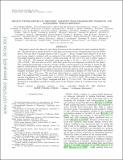The hot-Jupiter Kepler-17b: Discovery, obliquity from stroboscopic starspots, and atmospheric characterization
Author(s)
Demory, Brice-Olivier; Seager, Sara; Winn, Joshua Nathan
Downloadwinn17.pdf (1.733Mb)
OPEN_ACCESS_POLICY
Open Access Policy
Creative Commons Attribution-Noncommercial-Share Alike
Terms of use
Metadata
Show full item recordAbstract
This paper reports the discovery and characterization of the transiting hot giant exoplanet Kepler-17b. The planet has an orbital period of 1.486 days, and radial velocity measurements from the Hobby-Eberly Telescope show a Doppler signal of 419.5[superscript +13.3][subscript –15.6] m s[superscript –1]. From a transit-based estimate of the host star's mean density, combined with an estimate of the stellar effective temperature T[subscript eff] = 5630 ± 100 from high-resolution spectra, we infer a stellar host mass of 1.06 ± 0.07 M ⊙ and a stellar radius of 1.02 ± 0.03 R ⊙. We estimate the planet mass and radius to be M[subscript P] = 2.45 ± 0.11 M [subscript J] and R [subscript P] = 1.31 ± 0.02 R [subscript J]. The host star is active, with dark spots that are frequently occulted by the planet. The continuous monitoring of the star reveals a stellar rotation period of 11.89 days, eight times the planet's orbital period; this period ratio produces stroboscopic effects on the occulted starspots. The temporal pattern of these spot-crossing events shows that the planet's orbit is prograde and the star's obliquity is smaller than 15[degrees]. We detected planetary occultations of Kepler-17b with both the Kepler and Spitzer Space Telescopes. We use these observations to constrain the eccentricity, e, and find that it is consistent with a circular orbit (e < 0.011). The brightness temperatures of the planet's infrared bandpasses are T [subscript 3.6mum]=1880[plus or minus]100K and T[subscript 4.5mum]=1770 [plus or minus] 150K. We measure the optical geometric albedo A[subscript g] in the Kepler bandpass and find A[subscript g] = 0.10 ± 0.02. The observations are best described by atmospheric models for which most of the incident energy is re-radiated away from the day side.
Date issued
2011-11Department
Massachusetts Institute of Technology. Department of Earth, Atmospheric, and Planetary SciencesJournal
Astrophysical Journal. Supplement Series
Publisher
Institute of Physics Publishing
Citation
Désert, Jean-Michel et al. “THE HOT-JUPITER KEPLER-17b: DISCOVERY, OBLIQUITY FROM STROBOSCOPIC STARSPOTS, AND ATMOSPHERIC CHARACTERIZATION.” The Astrophysical Journal Supplement Series 197.1 (2011): 14.
Version: Author's final manuscript
ISSN
0067-0049
1538-4365